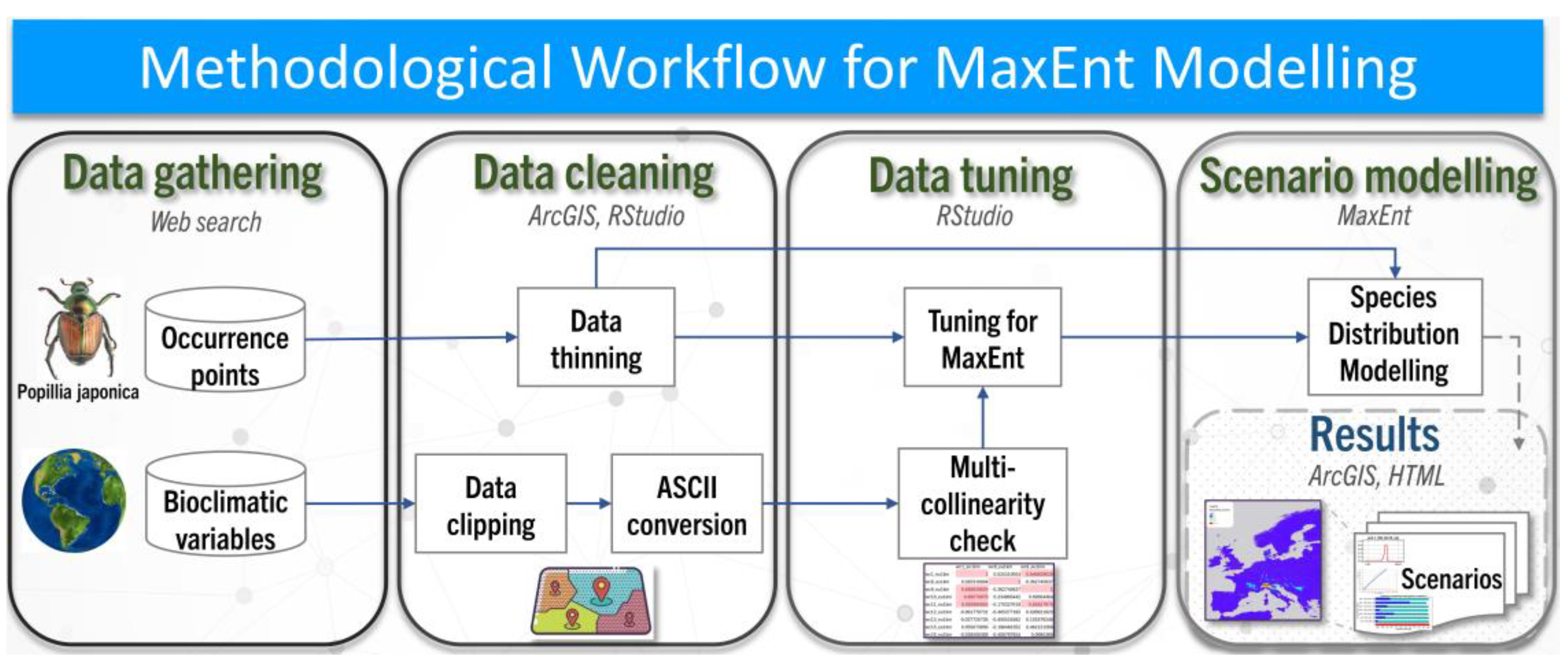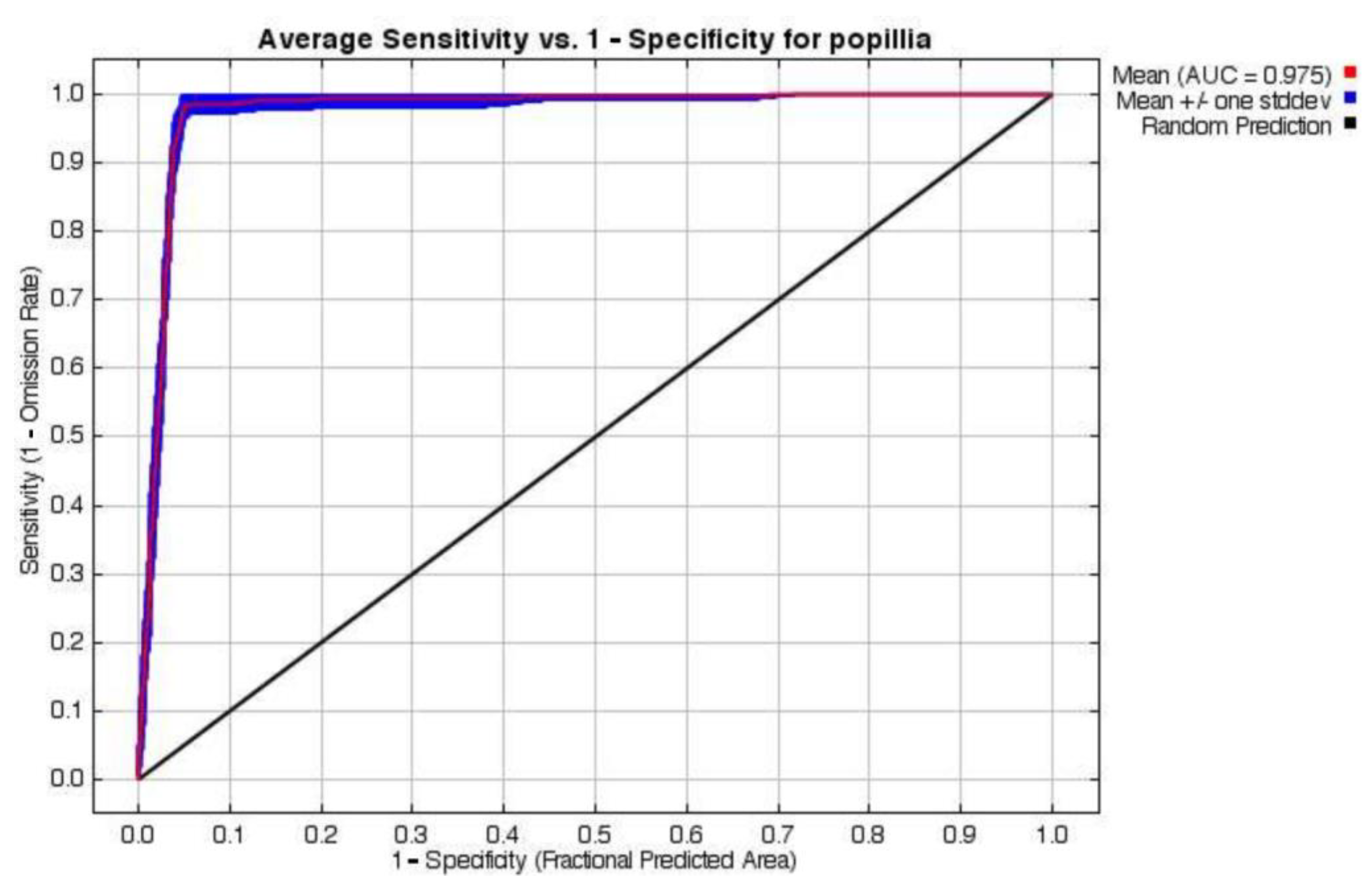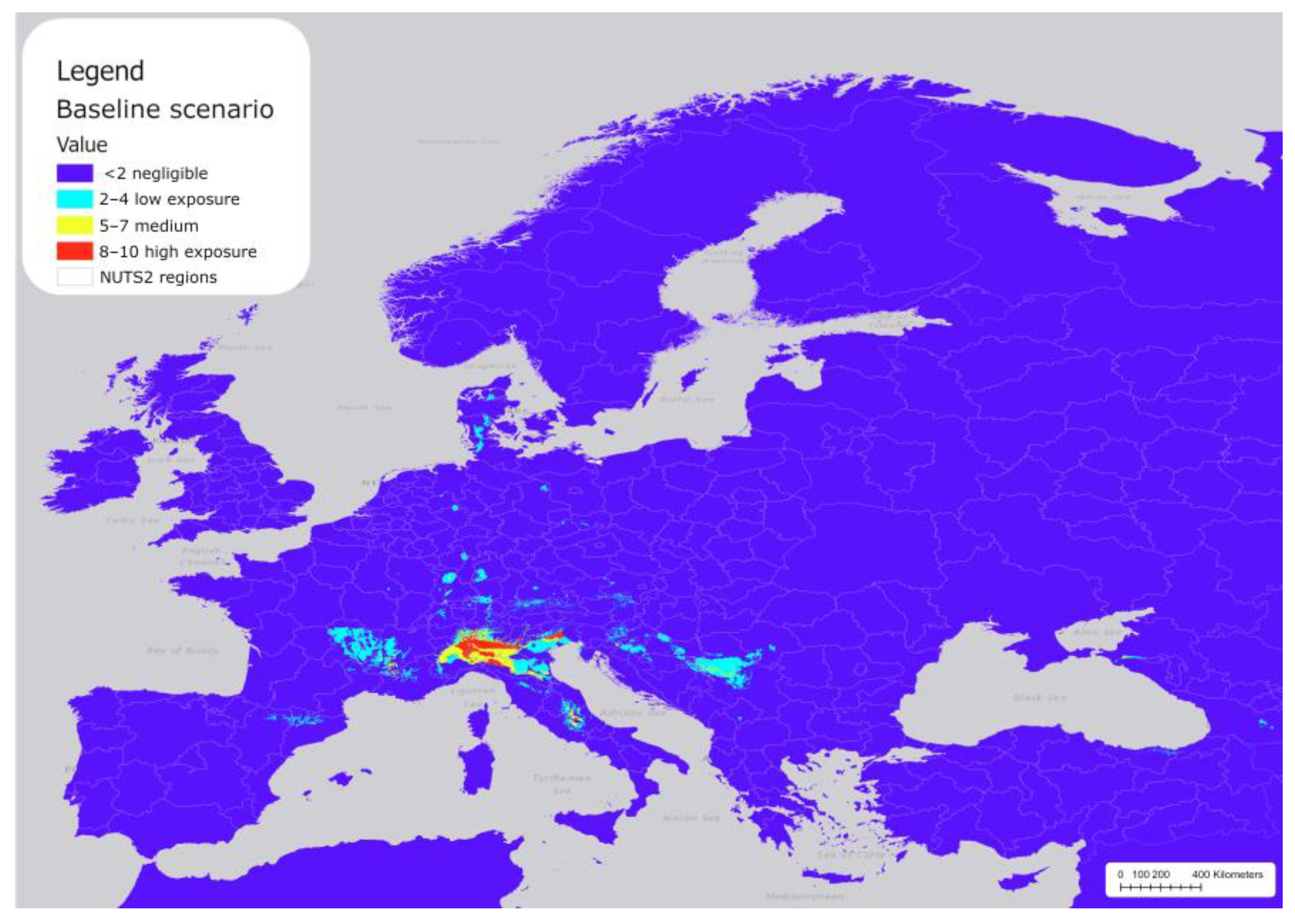Climate-Driven Invasion Risks of Japanese Beetle (Popillia japonica Newman) in Europe Predicted Through Species Distribution Modelling
Abstract
1. Introduction
2. Materials and Methods
2.1. Occurrence Data on P. japonica
2.2. Bioclimatic Variables
2.3. MaxEnt Model
2.4. Model Setup and Analysis
3. Results
3.1. Dominant Environmental Variables
3.2. Model Performance
3.3. Potentially Suitable Area Under Baseline Scenario
3.4. Potentially Suitable Area Under Future Climate
4. Discussion
5. Conclusions
Supplementary Materials
Author Contributions
Funding
Institutional Review Board Statement
Data Availability Statement
Acknowledgments
Conflicts of Interest
Abbreviations
| AIC | Akaike Information Criterion |
| AUC | Area Under the Curve |
| ASCII | American Standard Code for Information Interchange |
| BIO | Bioclimatic Variables |
| BioClim | Bio-Climatic |
| CLIMEX | Climate Model for Species Distribution |
| CMCC | Euro-Mediterranean Center on Climate Change Foundation |
| EU | European Union |
| GBIF | Global Biodiversity Information Facility |
| HTML | Hypertext Markup Language |
| MAXENT | Maximum Entropy |
| NUTS | Nomenclature of Territorial Units for Statistics |
| RCPs | Representative Concentration Pathways |
| ROC | Receiver Operating Characteristic |
| SSPs | Shared Socioeconomic Pathways |
| WHO | World Health Organization |
References
- Turbelin, A.J.; Cuthbert, R.N.; Essl, F.; Haubrock, P.J.; Ricciardi, A.; Courchamp, F. Biological Invasions Are as Costly as Natural Hazards. Perspect. Ecol. Conserv. 2023, 21, 143–150. [Google Scholar] [CrossRef]
- Vantarová, K.H.; Eliáš, P.; Jiménez-Ruiz, J.; Tokarska-Guzik, B.; Cires, E. Biological Invasions in the Twenty-First Century: A Global Risk. Biologia 2023, 78, 1211–1218. [Google Scholar] [CrossRef]
- John, A.; Riat, A.K.; Ahmad Bhat, K.; Ganie, S.A.; Endarto, O.; Nugroho, C.; Handoko, H.; Wani, A.K. Adapting to Climate Extremes: Implications for Insect Populations and Sustainable Solutions. J. Nat. Conserv. 2024, 79, 126602. [Google Scholar] [CrossRef]
- Paini, D.R.; Sheppard, A.W.; Cook, D.C.; De Barro, P.J.; Worner, S.P.; Thomas, M.B. Global Threat to Agriculture from Invasive Species. Proc. Natl. Acad. Sci. USA 2016, 113, 7575–7579. [Google Scholar] [CrossRef] [PubMed]
- Sileshi, G.W.; Gebeyehu, S. Emerging Infectious Diseases Threatening Food Security and Economies in Africa. Glob. Food Sec. 2021, 28, 100479. [Google Scholar] [CrossRef]
- IPBES. Invasive Alien Species and Their Control; IPBES: Bonn, Germany, 2023; ISBN 9783947851379. [Google Scholar]
- WHO. A Health Perspective on the Role of the Environment in One Health; WHO Regional Office for Europe: Copenhagen, Denmark, 2022.
- Bragard, C.; Dehnen-Schmutz, K.; Di Serio, F.; Gonthier, P.; Jacques, M.; Jaques Miret, J.A.; Justesen, A.F.; Magnusson, C.S.; Milonas, P.; Navas-Cortes, J.A.; et al. Pest Categorisation of Popillia Japonica. EFSA J. 2018, 16, e05438. [Google Scholar] [CrossRef]
- Tayeh, C.; Poggi, C.; Desneuex, N.; Jactel, H.; Verheggen, F. Host Plants of Popillia Japonica: A Review. Data INRAE 2023. [Google Scholar] [CrossRef]
- Kistner-Thomas, E.J. The Potential Global Distribution and Voltinism of the Japanese Beetle (Coleoptera: Scarabaeidae) Under Current and Future Climates. J. Insect Sci. 2019, 19, 16. [Google Scholar] [CrossRef]
- Klein, M. Popillia Japonica (Japanese beetle). CABI Compend. 2022, 14, 1. [Google Scholar] [CrossRef]
- Gilioli, G.; Sperandio, G.; Simonetto, A.; Ciampitti, M.; Cavagna, B.; Bianchi, A.; Battisti, A.; Mori, N.; De Francesco, A.; Gervasio, P. Predicting the Spatio-Temporal Dynamics of Popillia Japonica Populations. J. Pest Sci. 2024, 97, 2059–2071. [Google Scholar] [CrossRef]
- Althoff, E.R.; Rice, K.B. Japanese Beetle (Coleoptera: Scarabaeidae) Invasion of North America: History, Ecology, and Management. J. Integr. Pest Manag. 2022, 13, 2. [Google Scholar] [CrossRef]
- Pavesi, M. Popillia Japonica Specie Aliena Invasiva Segnalata in Lombardia. L’informatore Agrar. 2014, 32, 53–55. [Google Scholar]
- EPPO Popillia Japonica (POPIJA)—Overview. Available online: https://gd.eppo.int/taxon/POPIJA (accessed on 24 October 2024).
- Straubinger, F.B.; Venus, T.E.; Benjamin, E.O.; Sauer, J. Private Management Costs of Popillia Japonica: A Study of Viticulture in Italy. Front. Insect Sci. 2023, 3, 1176405. [Google Scholar] [CrossRef] [PubMed]
- Borgogno-Mondino, E.; Lessio, F.; Bianchi, A.; Ciampitti, M.; Cavagna, B.; Alma, A. Modelling the Spread of Popillia Japonica Newman (Coleoptera: Scarabaeidae) from a Recently Infested Area. Entomol. Gen. 2022, 42, 713–721. [Google Scholar] [CrossRef]
- Della Rocca, F.; Milanesi, P. The Spread of the Japanese Beetle in a European Human-Dominated Landscape: High Anthropization Favors Colonization of Popillia Japonica. Diversity 2022, 14, 658. [Google Scholar] [CrossRef]
- Zhu, G.; Li, H.; Zhao, L. Incorporating Anthropogenic Variables into Ecological Niche Modeling to Predict Areas of Invasion of Popillia Japonica. J. Pest Sci. 2017, 90, 151–160. [Google Scholar] [CrossRef]
- Della Rocca, F.; Milanesi, P. The New Dominator of the World: Modeling the Global Distribution of the Japanese Beetle under Land Use and Climate Change Scenarios. Land 2022, 11, 567. [Google Scholar] [CrossRef]
- Borner, L.; Martinetti, D.; Poggi, S. A New Chapter of the Japanese Beetle Invasion Saga: Predicting Suitability from Long-Invaded Areas to Inform Surveillance Strategies in Europe. Entomol. Gen. 2023, 43, 951–960. [Google Scholar] [CrossRef]
- Melo-Merino, S.M.; Reyes-Bonilla, H.; Lira-Noriega, A. Ecological Niche Models and Species Distribution Models in Marine Environments: A Literature Review and Spatial Analysis of Evidence. Ecol. Modell. 2020, 415, 108837. [Google Scholar] [CrossRef]
- Phillips, S.J.; Anderson, R.P.; Schapire, R.E. Maximum Entropy Modeling of Species Geographic Distributions. Ecol. Modell. 2006, 190, 231–259. [Google Scholar] [CrossRef]
- Elith, J.; Phillips, S.J.; Hastie, T.; Dudík, M.; Chee, Y.E.; Yates, C.J. A Statistical Explanation of MaxEnt for Ecologists. Divers. Distrib. 2011, 17, 43–57. [Google Scholar] [CrossRef]
- Riahi, K.; van Vuuren, D.P.; Kriegler, E.; Edmonds, J.; O’Neill, B.C.; Fujimori, S.; Bauer, N.; Calvin, K.; Dellink, R.; Fricko, O.; et al. The Shared Socioeconomic Pathways and Their Energy, Land Use, and Greenhouse Gas Emissions Implications: An Overview. Glob. Environ. Chang. 2017, 42, 153–168. [Google Scholar] [CrossRef]
- GBIF. GBIF—The Global Biodiversity Information Facility. Available online: https://www.gbif.org/ (accessed on 7 November 2024).
- Tu, W.; Xiong, Q.; Qiu, X.; Zhang, Y. Dynamics of Invasive Alien Plant Species in China under Climate Change Scenarios. Ecol. Indic. 2021, 129, 107919. [Google Scholar] [CrossRef]
- Mao, M.; Chen, S.; Ke, Z.; Qian, Z.; Xu, Y. Using MaxEnt to Predict the Potential Distribution of the Little Fire Ant (Wasmannia auropunctata) in China. Insects 2022, 13, 1008. [Google Scholar] [CrossRef]
- Hou, J.; Xiang, J.; Li, D.; Liu, X. Prediction of Potential Suitable Distribution Areas of Quasipaa Spinosa in China Based on MaxEnt Optimization Model. Biology 2023, 12, 366. [Google Scholar] [CrossRef]
- Pintilioaie, A.-M.; Sfîcă, L.; Baltag, E.S. Climatic Niche of an Invasive Mantid Species in Europe: Predicted New Areas for Species Expansion. Sustainability 2023, 15, 10295. [Google Scholar] [CrossRef]
- Zhao, Z.; Yang, L.; Chen, X. Globally Suitable Areas for Lycorma Delicatula Based on an Optimized Maxent Model. Ecol. Evol. 2024, 14, e70252. [Google Scholar] [CrossRef]
- Fick, S.E.; Hijmans, R.J. WorldClim 2: New 1-km Spatial Resolution Climate Surfaces for Global Land Areas. Int. J. Climatol. 2017, 37, 4302–4315. [Google Scholar] [CrossRef]
- O’Neill, B.C.; Kriegler, E.; Riahi, K.; Ebi, K.L.; Hallegatte, S.; Carter, T.R.; Mathur, R.; van Vuuren, D.P. A New Scenario Framework for Climate Change Research: The Concept of Shared Socioeconomic Pathways. Clim. Change 2014, 122, 387–400. [Google Scholar] [CrossRef]
- Phillips, S.J.; Anderson, R.P.; Dudík, M.; Schapire, R.E.; Blair, M.E. Opening the Black Box: An Open-source Release of Maxent. Ecography Cop. 2017, 40, 887–893. [Google Scholar] [CrossRef]
- Aiello-Lammens, M.E.; Boria, R.A.; Radosavljevic, A.; Vilela, B.; Anderson, R.P. SpThin: An R Package for Spatial Thinning of Species Occurrence Records for Use in Ecological Niche Models. Ecography Cop. 2015, 38, 541–545. [Google Scholar] [CrossRef]
- Warren, D.; Dinnage, R. ENMTools: Analysis of Niche Evolution Using Niche and Distribution Models. CRAN Contrib. Packag. 2020. Available online: https://cran.r-project.org/web/packages/ENMTools/ (accessed on 1 June 2024).
- Potter, D.A.; Held, D.W. Biology and Management of the Japanese Beetle. Annu. Rev. Entomol. 2002, 47, 175–205. [Google Scholar] [CrossRef] [PubMed]
- Zhao, Y.; Zhang, L.; Wang, C. Predicting Possible Distribution of Rice Leaf Roller (Cnaphalocrocis medinalis) under Climate Change Scenarios Using MaxEnt Model in China. Sci. Rep. 2024, 14, 21245. [Google Scholar] [CrossRef]
- Bosio, G.; Piazza, E.; Giacometto, E. Popillia Japonica, Una Specie in Progressiva Diffusione. L’informatore Agrar. 2022, 21, 53–58. [Google Scholar]
- Simonetto, A.; Sperandio, G.; Battisti, A.; Mori, N.; Ciampitti, M.; Cavagna, B.; Bianchi, A.; Gilioli, G. Exploring the Main Factors Influencing Habitat Preference of Popillia Japonica in an Area of Recent Introduction. Ecol. Inform. 2022, 70, 101749. [Google Scholar] [CrossRef]
- Skendžić, S.; Zovko, M.; Živković, I.P.; Lešić, V.; Lemić, D. The Impact of Climate Change on Agricultural Insect Pests. Insects 2021, 12, 440. [Google Scholar] [CrossRef]
- Pulighe, G.; Di Fonzo, A.; Gaito, M.; Giuca, S.; Lupia, F.; Bonati, G.; De Leo, S. Climate Change Impact on Yield and Income of Italian Agriculture System: A Scoping Review. Agric. Food Econ. 2024, 12, 23. [Google Scholar] [CrossRef]
- Straubinger, F.B.; Benjamin, E.O.; Venus, T.E.; Sauer, J. The Economic Importance of Early Pest Control: New Insights from Potential Popillia Japonica Infestation in Europe. agriRxiv 2022, 20220316785. [Google Scholar] [CrossRef]





| Scenario | Period | Description |
|---|---|---|
| Baseline | 1970–2000 | Historical reference data |
| SSP1-2.6 | 2021–2040 | Simulation with sustainability targets |
| SSP1-2.6 | 2041–2060 | Simulation with sustainability targets |
| SSP2-4.5 | 2021–2040 | Intermediate development scenario |
| SSP2-4.5 | 2041–2060 | Intermediate development scenario |
| SSP5-8.5 | 2021–2040 | High-emission scenario |
| SSP5-8.5 | 2041–2060 | High-emission scenario |
| Variable | Percent Contribution | Permutation Importance |
|---|---|---|
| BIO7 | 3.1 | 2.9 |
| BIO8 | 4.7 | 0.3 |
| BIO10 | 14.5 | 4.8 |
| BIO11 | 44 | 77.2 |
| BIO15 | 13.7 | 0.6 |
| BIO18 | 14.4 | 11.8 |
| BIO19 | 5.6 | 2.3 |
| Class | Baseline | 2021–2040 | 2041–2060 | ||||
|---|---|---|---|---|---|---|---|
| SSP1-2.6 | SSP2-4.5 | SSP5-8.5 | SSP1-2.6 | SSP2-4.5 | SSP5-8.5 | ||
| 0.2 | 22,557.4 | 29,332.4 | 29,021.6 | 26,592.6 | 27,812 | 21,471.4 | 28,981.6 |
| 0.3 | 11,153.1 | 18,105 | 15,515.1 | 12,437.4 | 23,076.6 | 17,023.8 | 17,583.6 |
| 0.4 | 6818.4 | 9680 | 9156.8 | 7057.2 | 15,815.6 | 10,828.8 | 11,537.6 |
| 0.5 | 5877.5 | 8617.5 | 6047 | 6639.5 | 11,522.5 | 7224 | 9656.5 |
| 0.6 | 7311 | 6894 | 6788.4 | 9843 | 8709 | 8926.2 | 8199 |
| 0.7 | 11,746 | 9103.5 | 7424.2 | 11,648.7 | 10,537.8 | 11,526.9 | 9821.7 |
| 0.8 | 14,251.2 | 10,868 | 10,943.2 | 17,188 | 13,041.6 | 14,744 | 12,524 |
| 0.9 | 4091.4 | 3659.4 | 6103.8 | 2282.4 | 8494.2 | 4492.8 | 6482.7 |
| 1 | 1 | 45 | 1981 | 0 | 1427 | 11 | 433 |
| Total | 83,807 | 96,304 | 92,981 | 93,688 | 120,436 | 96,248 | 105,219 |
Disclaimer/Publisher’s Note: The statements, opinions and data contained in all publications are solely those of the individual author(s) and contributor(s) and not of MDPI and/or the editor(s). MDPI and/or the editor(s) disclaim responsibility for any injury to people or property resulting from any ideas, methods, instructions or products referred to in the content. |
© 2025 by the authors. Licensee MDPI, Basel, Switzerland. This article is an open access article distributed under the terms and conditions of the Creative Commons Attribution (CC BY) license (https://creativecommons.org/licenses/by/4.0/).
Share and Cite
Pulighe, G.; Lupia, F.; Manente, V. Climate-Driven Invasion Risks of Japanese Beetle (Popillia japonica Newman) in Europe Predicted Through Species Distribution Modelling. Agriculture 2025, 15, 684. https://doi.org/10.3390/agriculture15070684
Pulighe G, Lupia F, Manente V. Climate-Driven Invasion Risks of Japanese Beetle (Popillia japonica Newman) in Europe Predicted Through Species Distribution Modelling. Agriculture. 2025; 15(7):684. https://doi.org/10.3390/agriculture15070684
Chicago/Turabian StylePulighe, Giuseppe, Flavio Lupia, and Valentina Manente. 2025. "Climate-Driven Invasion Risks of Japanese Beetle (Popillia japonica Newman) in Europe Predicted Through Species Distribution Modelling" Agriculture 15, no. 7: 684. https://doi.org/10.3390/agriculture15070684
APA StylePulighe, G., Lupia, F., & Manente, V. (2025). Climate-Driven Invasion Risks of Japanese Beetle (Popillia japonica Newman) in Europe Predicted Through Species Distribution Modelling. Agriculture, 15(7), 684. https://doi.org/10.3390/agriculture15070684






